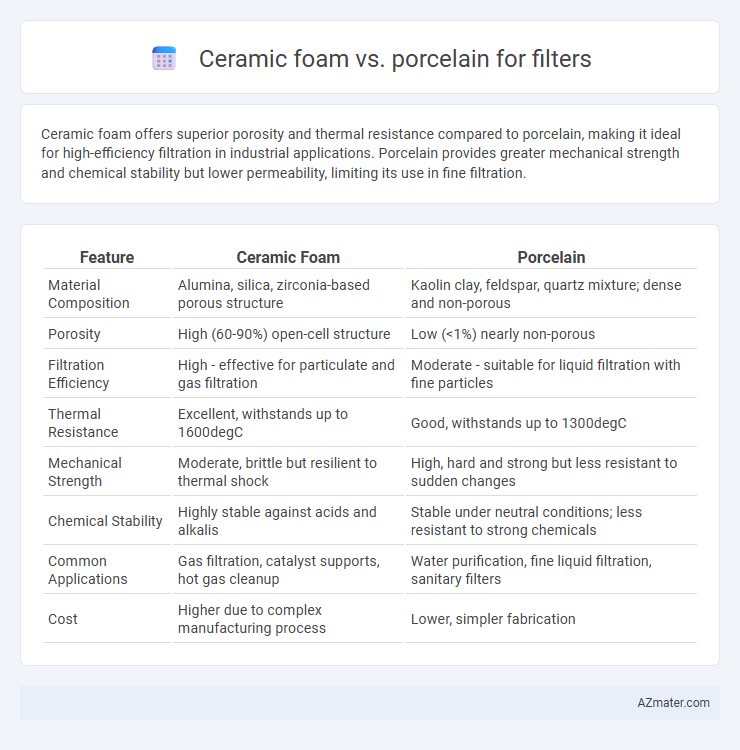Ceramic foam offers superior porosity and thermal resistance compared to porcelain, making it ideal for high-efficiency filtration in industrial applications. Porcelain provides greater mechanical strength and chemical stability but lower permeability, limiting its use in fine filtration.
Table of Comparison
| Feature | Ceramic Foam | Porcelain |
|---|---|---|
| Material Composition | Alumina, silica, zirconia-based porous structure | Kaolin clay, feldspar, quartz mixture; dense and non-porous |
| Porosity | High (60-90%) open-cell structure | Low (<1%) nearly non-porous |
| Filtration Efficiency | High - effective for particulate and gas filtration | Moderate - suitable for liquid filtration with fine particles |
| Thermal Resistance | Excellent, withstands up to 1600degC | Good, withstands up to 1300degC |
| Mechanical Strength | Moderate, brittle but resilient to thermal shock | High, hard and strong but less resistant to sudden changes |
| Chemical Stability | Highly stable against acids and alkalis | Stable under neutral conditions; less resistant to strong chemicals |
| Common Applications | Gas filtration, catalyst supports, hot gas cleanup | Water purification, fine liquid filtration, sanitary filters |
| Cost | Higher due to complex manufacturing process | Lower, simpler fabrication |
Overview of Ceramic Foam and Porcelain Filters
Ceramic foam filters offer a porous structure with high permeability, enabling efficient filtration of molten metals by trapping non-metallic inclusions while maintaining strong mechanical strength at high temperatures. Porcelain filters consist of fine, dense ceramic materials that provide superior filtration precision and chemical resistance, making them ideal for applications requiring clean and defect-free metal castings. Both materials improve casting quality, but ceramic foam filters excel in permeability and thermal shock resistance, whereas porcelain filters prioritize filtration accuracy and surface smoothness.
Material Composition and Structure
Ceramic foam filters, composed primarily of alumina, silica, and zirconia oxides, feature a porous, open-cell structure that enables efficient fluid filtration and high permeability. Porcelain filters, made from kaolin clay, feldspar, and quartz, possess a dense, fine-grained microstructure providing excellent mechanical strength and lower porosity. The choice between ceramic foam and porcelain filters hinges on the required balance between filtration efficiency, thermal resistance, and mechanical durability in specific industrial applications.
Filtration Efficiency Comparison
Ceramic foam filters outperform porcelain filters in filtration efficiency due to their highly porous structure, which allows for superior particle entrapment and enhanced flow distribution. The interconnected pores of ceramic foam provide a larger surface area, resulting in improved removal of impurities and inclusions during metal casting or liquid filtration processes. Porcelain filters, while durable, typically feature less porosity and smaller pore size distribution, leading to lower filtration performance in comparison.
Durability and Lifespan
Ceramic foam filters offer high durability due to their open-cell structure, providing excellent resistance to thermal shock and mechanical stress, which extends their lifespan in industrial filtration applications. Porcelain filters, while dense and effective at trapping fine particles, generally have lower thermal shock resistance, leading to a shorter operational lifespan under high-temperature cycling conditions. Selecting ceramic foam over porcelain results in longer filter service life and reduced maintenance frequency in demanding filtering environments.
Thermal Resistance and Stability
Ceramic foam filters exhibit superior thermal resistance due to their porous structure, which allows better heat dissipation and withstands temperatures up to 1600degC, making them ideal for high-temperature filtration processes. Porcelain filters, while offering excellent chemical stability and mechanical strength, typically have lower thermal shock resistance and can degrade faster under extreme thermal cycles compared to ceramic foam. The enhanced thermal stability of ceramic foam ensures prolonged filter life and consistent performance in demanding metallurgical and industrial applications.
Applications in Industrial Filtration
Ceramic foam filters excel in high-temperature industrial filtration due to their porous structure, allowing efficient removal of inclusions in molten metals such as aluminum and steel. Porcelain filters, known for their fine grain and chemical inertness, are commonly used in pharmaceutical and chemical industries for filtering corrosive liquids and gases. The choice between ceramic foam and porcelain filters depends on the specific filtration needs, temperature resistance, and chemical compatibility requirements of the industrial application.
Cost Analysis and Availability
Ceramic foam filters generally offer a cost-effective solution compared to porcelain filters due to lower raw material expenses and simpler manufacturing processes, resulting in more competitive pricing for large-scale industrial applications. Porcelain filters, while often pricier because of their refined materials and intricate production techniques, provide longer lifespan and superior durability, which can offset initial costs over time. Availability favors ceramic foam filters as they are widely produced and accessible globally, whereas porcelain filters may have limited suppliers and longer lead times depending on regional manufacturing capabilities.
Environmental Impact and Sustainability
Ceramic foam filters offer superior environmental benefits compared to porcelain filters due to their longer lifespan and higher recyclability, reducing waste generation significantly. Porcelain filters, while effective, generally require more frequent replacement and involve energy-intensive production processes that contribute to higher carbon emissions. The porous structure of ceramic foam enhances filtration efficiency, leading to less material consumption and a smaller environmental footprint in industrial applications.
Maintenance and Cleaning Requirements
Ceramic foam filters offer superior ease of maintenance due to their porous structure, allowing contaminants to be trapped on the surface, which simplifies cleaning with low-pressure washing or ultrasonic methods. Porcelain filters, while denser and less porous, require more intensive cleaning processes such as chemical soaking or abrasive techniques to remove embedded particles, increasing downtime and maintenance costs. The durability and regeneration cycle of ceramic foam filters typically outperform porcelain, reducing overall maintenance frequency in filtration systems.
Choosing the Right Filter Material
Ceramic foam filters offer superior thermal shock resistance and high porosity, making them ideal for filtering molten metals with efficient inclusion removal. Porcelain filters provide excellent chemical stability and fine filtration capability but may lack the mechanical strength required for high-flow or highly abrasive applications. Selecting the right filter material depends on balancing factors such as operating temperature, filtration precision, and durability demands specific to the casting process.

Infographic: Ceramic foam vs Porcelain for Filter
 azmater.com
azmater.com